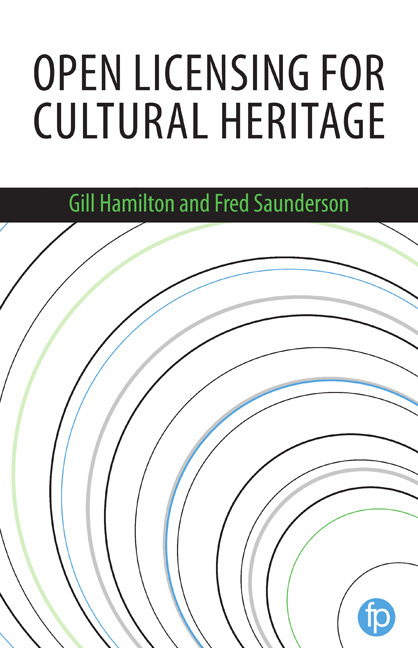Book contents
- Frontmatter
- Contents
- List of figures and tables
- Acknowledgements
- About the authors
- 1 Introduction
- 2 The open movement: its history and development
- 3 Copyright and licensing: a background
- 4 Open licensing: the logical option for cultural heritage
- Introduction to case studies
- 5 Small steps, big impact – how SMK became SMK Open
- 6 The British Library experience of open metadata licensing
- 7 Open policy and collaboration with Wikimedia at the National Library of Wales
- 8 Newcastle Libraries – the public library as a place to share culture
- 9 Developing open licensing at the National Library of Scotland
- 10 The Wellcome Library
- 11 Developing an open educational resources policy and open approaches to mitigate risk at University of Edinburgh
- 12 How to implement open licensing
- 13 Using and reusing openly licensed resources
- 14 Conclusion
- Index
13 - Using and reusing openly licensed resources
Published online by Cambridge University Press: 08 June 2018
- Frontmatter
- Contents
- List of figures and tables
- Acknowledgements
- About the authors
- 1 Introduction
- 2 The open movement: its history and development
- 3 Copyright and licensing: a background
- 4 Open licensing: the logical option for cultural heritage
- Introduction to case studies
- 5 Small steps, big impact – how SMK became SMK Open
- 6 The British Library experience of open metadata licensing
- 7 Open policy and collaboration with Wikimedia at the National Library of Wales
- 8 Newcastle Libraries – the public library as a place to share culture
- 9 Developing open licensing at the National Library of Scotland
- 10 The Wellcome Library
- 11 Developing an open educational resources policy and open approaches to mitigate risk at University of Edinburgh
- 12 How to implement open licensing
- 13 Using and reusing openly licensed resources
- 14 Conclusion
- Index
Summary
Introduction
This chapter describes what you, your colleagues and people who use your services and content need to know about using and reusing openly licensed resources. It also outlines a range of tools, techniques and services that can be used to help find and correctly attribute open content and explains how to distribute resources to third party services where they can reach more users and have greater impact.
Correct use of open resources
The internet is awash with an ever-increasing wealth of openly licensed resources, all of which is available to organisations to use and reuse for almost any purpose: there are images that can be used in presentations, posters and documents, texts and data to support research, courseware and videos to help train staff, operating systems and software applications to underpin business processes, and your organisation's own open content. By using open material you not only champion and support the open movement but are likely to save your organisation money, since open resources are generally free to use and repurpose.
It is important to make proper and correct use of openly licensed resources, and to ensure staff have at least a basic grasp of the obligations set out in open licences. Like your users, staff do not need to develop an in-depth knowledge of open licensing, but need enough of an understanding to use open resources correctly so as not to expose the organisation to the risks associated with misuse, inadvertent or otherwise.
Staff should be aware of the most common types of open licences that they are likely to encounter when sourcing resources for reuse. This requires explanation and documentation in plain and clear language about licensing frameworks, such as Creative Commons licences, the Open Government Licence and GNU licences. As Creative Commons is the open licensing framework most used in the cultural heritage sector it is worth going into more detail to explain the concepts of Attribution, ShareAlike, NonCommercial and NoDerivatives. Creative Commons Australia's colourful licensing fact sheet, which is openly licensed itself (under a CC BY licence), could be a useful starting point and can be adapted to suit the needs of your organisation. Staff require a basic understanding of the public domain and the parameters of copyright duration for works in different formats and within different jurisdictions.
- Type
- Chapter
- Information
- Open Licensing for Cultural Heritage , pp. 193 - 208Publisher: FacetPrint publication year: 2017



